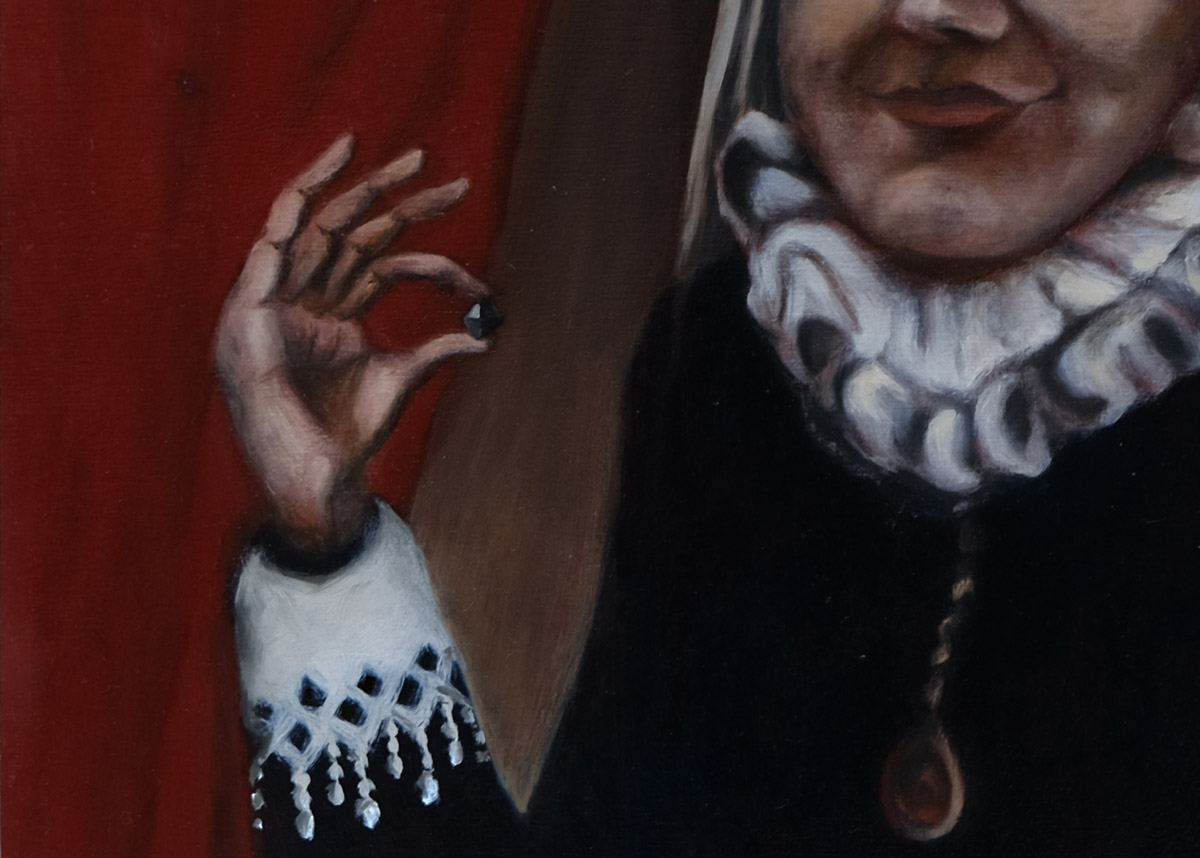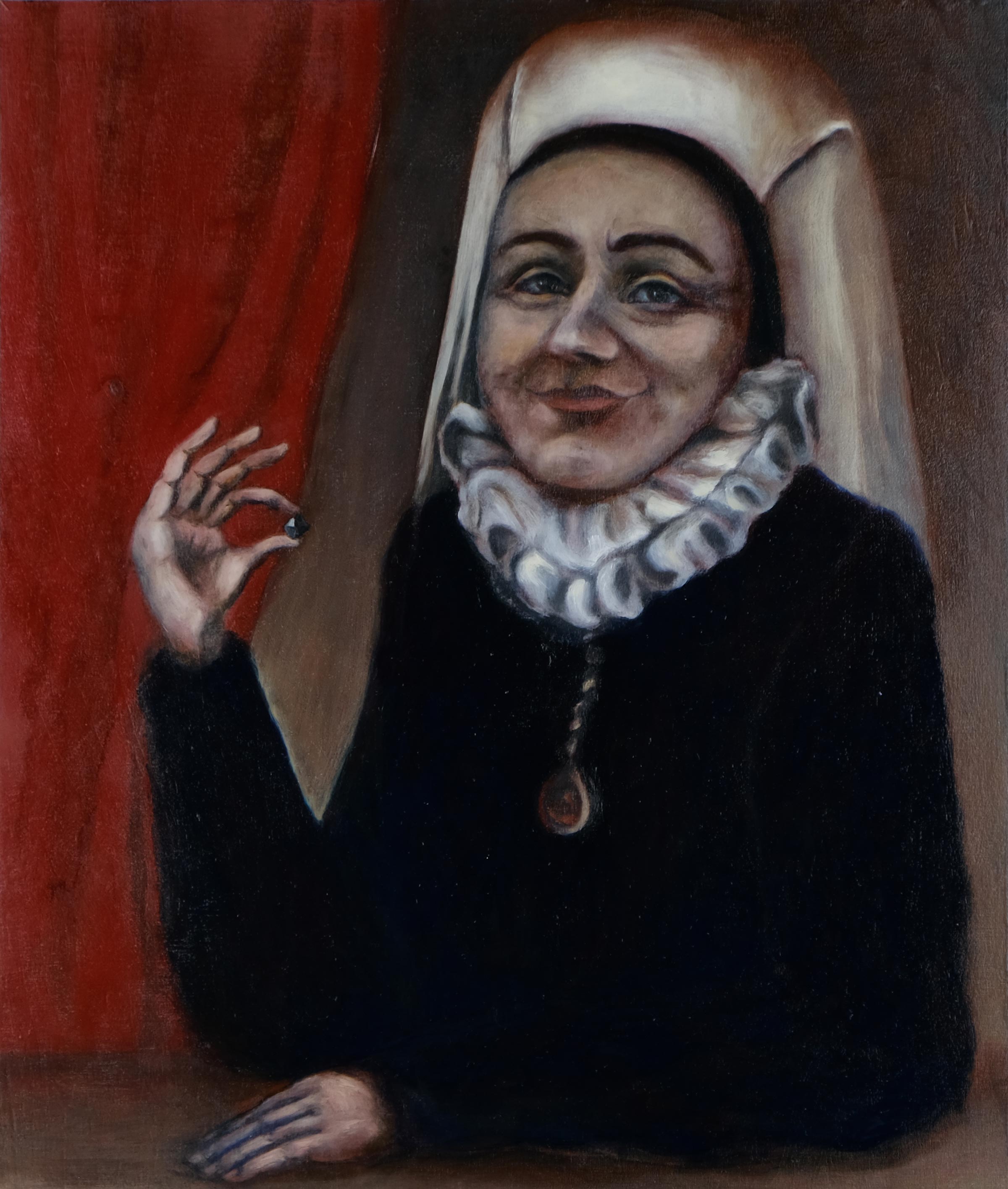
Marie Colinet
Surgeon & Midwife in the late 16th century
Marie Colinet
* before 1587 Geneva (Switzerland), † ~1638 Bern (Switzerland)
Marie Colinet, also known as Maria Colinet and Marie von Hilden, was a surgeon and midwife at a time when healers traveled the country and only the best were declared “city doctors”. This was the case for her husband Wilhelm Fabry (Wilhelm von Hilden), who documented his medical practice in great detail and is still known today as “the German father of surgery” and the city doctor of Bern. Meanwhile, Marie herself must have been an extraordinary doctor as of her husband's writings.
About the Portrait
Is this Marie Colinet?
There is no confirmed portrait of Marie Colinet. We do not know her facial features and we can only speculate that she wore a typical midwife's cap of the time. This portrait I designed shows my idea of Marie Colinet. She is holding a magnet between her index finger and thumb, with which she first carried out the so-called magnet extraction on the eye. I chose the picture format and pose so that Marie matches the (presumably only) existing portrait of her husband Wilhelm Fabry.
Biography
A medically highly educated woman with precise knowledge of how to perform surgical procedures and treat wounds
The exact year of Marie Colinet's birth is not known. Her marriage to Wilhelm von Hilden (1560-1634) is documented for 1587, so she was probably born around 1570 or earlier.
Marie's father Eustache Colinet (married to Clauda Cordier) came to Geneva in 1579 as a bookseller and publisher. In the 16th century, Geneva was the reformist center of Calvinism and a place of refuge for expelled Huguenots from France. In the 1570s, there is a wave of refugees as a result of St. Bartholomew's Day (1572). Marie's father remained in Geneva until his death in 1588, as did Marie and her husband Wilhelm, who moved to Hilden for three years after his father's death (1589-1592). However, Marie and Wilhelm spent the longest part of their lives in Bern, where Wilhelm was eventually appointed city physician.
While very little is known about Marie Colinet, her husband is documented in great detail. There is no documented portrait of her, but there is one of Wilhelm, which is now in the university archives of the University of Bern and a copy in the Wilhelm Fabry House in his home town of Hilden. To this day, he is known as the “German father of surgery from Hilden”. Wilhelm first received his medical training in nearby Düsseldorf and then went to Geneva, which was known for its excellent doctors at the time. It was here that Marie and Wilhelm met.
We know that Marie Colinet could read and write; her brothers Jean and Pierre were also doctors (see: Olivier, 1961, page 491). However, we do not know whether Marie had any medical knowledge of her own before her marriage to Wilhelm. As her brothers were also doctors, this may well have been the case. We can tell from her husband's works that Marie learned the practice of surgery from him (perhaps not exclusively). He repeatedly mentions Marie in praise in his “Chirurgische Wahrnehmungen” (Observaciones): his wife was a “learned woman, knowledgeable in anatomy and surgery”, and had also given excellent examples of her skill in “extracting the dead fruit from the womb.” (quoted from Schönfeld, 1947, page 104) Even in his will, he makes caring arrangements for Marie (see: Schönfeld, 1947, page 105).
This appreciation seems all the more important given that Wilhelm Fabry deliberately did not record all his knowledge in his “observaciones” because, according to his own information, he considered the barbers (who also performed operations) and midwives of his time to be too dull and simple-minded to apply this knowledge correctly and without harming the patient.

Excerpt from Wilhelm Fabry's Obs. 21 (Centuria V) on magnetic extraction, which his wife apparently performed for the first time and which is now attributed to him alone in medical history books, although the original wording suggests otherwise:
"Meanwhile my housewife has devised a much more useful remedy. Then, by opening the eyelids with both hands, she held a magnetic stone so close to the eye as the sick man could bare. After we had done this several times, and that by repetition (then he was not able to stay in the strong light for long - but we were in great need of it to do this - the slag finally jumped out of the eye at the magnet, so that we all watched. Afterwards, when we used a pain-relieving eyewash, he soon recovered."
Original German passage: "Unterdessen hat mein Hausfrau ein viel taugenlichers Mittel erdacht. Dann in dem ich mit beeden Händen die Augenlieder auffgethan hat sie ein Magnetstein so nahe zu dem Aug gehalten, als der Krancke hart leyden mögen. Welches als wir es etlich mahlen und zwar durch Widerholung gethan (dann er hat das Liecht nicht lang leyden können – dessen wir aber zu dieser Verrichtung hoch vonnöthen gehabt – ist endlich die Schlacken aus dem Aug an den Magnet gesprungen, daß wir alle zugesehen haben. Nachgehends als wir ein Schmerzen stillend Augenwasser gebraucht, ist er in Kürze wider gesund worden."
In his texts, Wilhelm Fabry speaks highly of his wife throughout his life and repeatedly mentions her in praise: Centuria VI: Obs. 63, Centuria II: Obs. 56 (Marie's pregnancy), Centuria II: Obs. 91, Centuria V: Obs. 21 (magnet extraction).
Historical Images and Texts
Marie Colinet' book, Wilhelm Fabry's (Fabricius Hildanus) Portrait
(click on the picture for enlargement and caption)





